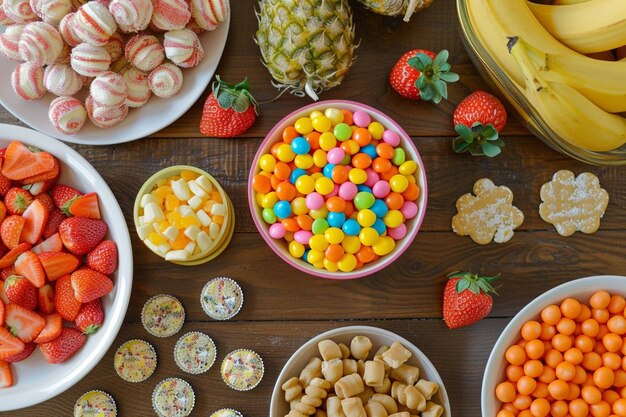Is the ‘Girl Dinner’ Trend Over? Impact on Food Brands & US Consumers

Anúncios
The ‘Girl Dinner’ trend, characterized by curated snack plates, gained viral popularity but now faces decline, impacting food brands and consumer behavior in the US as preferences shift towards more structured and balanced meals.
Anúncios
The ‘Girl Dinner’ trend, a social media phenomenon featuring aesthetically pleasing plates of snacks and easy-to-assemble foods, took the internet by storm. But is the appeal waning? Let’s delve into analyzing its impact on food brands and consumer behavior in the US.
Understanding the ‘Girl Dinner’ Phenomenon
The ‘Girl Dinner’ trend emerged as a seemingly simple yet significant movement on social media, particularly on platforms like TikTok and Instagram. It centered around the idea of assembling a meal from various snackable items, often presented in an aesthetically pleasing manner.
Anúncios
This trend resonated deeply with many individuals, primarily women, who found it to be a convenient, customizable, and relatable way to approach mealtime. The appeal lay in the simplicity and freedom it offered, allowing for creative combinations and personalized selections.
The rise of the Girl Dinner
Several factors contributed to the skyrocketing popularity of the Girl Dinner trend. Firstly, it offered a refreshing alternative to the often-rigid structures of conventional meal planning and preparation. The ease and flexibility of assembling a dinner from snacks appealed to those with busy lifestyles or limited time.
Secondly, the trend tapped into a sense of community and shared experience. As users posted their own Girl Dinner creations, it fostered a feeling of connection and camaraderie. This online interaction further amplified the trend’s reach and influence.
- Convenience: The Girl Dinner trend provided a quick and easy meal solution, ideal for busy individuals.
- Customization: Participants could tailor their plates to their personal preferences and dietary needs.
- Community: The trend fostered a sense of shared experience and connection among users.
- Aesthetic appeal: The visually pleasing presentation of Girl Dinner plates added to the trend’s appeal.
The ‘Girl Dinner’ trend represented a departure from traditional meal formats, emphasizing ease, personalization, and community. Its swift rise mirrored the growing cultural emphasis on flexibility and self-expression in everyday life.
Analyzing the Impact on Food Brands
The ‘Girl Dinner’ trend had a notable impact on food brands, particularly those specializing in snackable and convenience items. Companies that aligned with the trend’s core principles experienced increased visibility and sales.
However, the trend also presented challenges, requiring brands to adapt their marketing strategies and product offerings to remain relevant in the ever-evolving landscape of consumer tastes.
Winners in the Girl Dinner Game
Certain food brands benefited significantly from the Girl Dinner trend. Cheese companies, cracker manufacturers, and producers of dips and spreads saw a surge in demand as consumers incorporated these products into their snack plates.
Brands that actively engaged with the trend on social media, showcasing creative ways to use their products in Girl Dinners, achieved even greater success. This proactive approach helped them resonate with consumers and solidify their position within the trend.

The Girl Dinner trend influenced food brands to market their products differently. Brands now focus on convenience, snackability, and visual appeal in order to appeal to consumers who are into the Girl Dinner trend.
- Increased sales: Brands specializing in snackable items experienced a boost in sales.
- Enhanced brand visibility: Companies that actively engaged with the trend on social media gained increased visibility.
- Product innovation: Some brands introduced new products specifically designed for Girl Dinners.
The ‘Girl Dinner’ trend created both opportunities and challenges for food brands. Those who successfully adapted to the trend’s demands and embraced its core values reaped the rewards, while those who remained static risked being left behind.
Consumer Behavior Shifts Driven by the Trend
The Girl Dinner trend not only influenced food brands but also contributed to shifts in consumer behavior. It encouraged individuals to rethink traditional meal structures and embrace more flexible and personalized approaches to eating.
Furthermore, the trend highlighted the growing importance of social media in shaping consumer choices and preferences. The influence of online communities and content creators became increasingly evident.
Snacking as a Meal Replacement
One of the key behavioral shifts driven by the Girl Dinner trend was the growing acceptance of snacking as a legitimate meal replacement. Instead of adhering to the traditional three-meals-a-day format, many consumers began to view a collection of snacks as a satisfying and convenient alternative.
This shift was particularly pronounced among younger demographics, who are more likely to embrace unconventional eating habits and prioritize convenience and customization.
The trend showed that many consumers are willing to abandon the conventional meal structure and prefer snacking through the day.
- Embracing flexibility: Consumers became more open to unconventional meal formats.
- Prioritizing convenience: The trend catered to the demand for quick and easy meal solutions.
- Seeking personalization: Consumers valued the ability to customize their meal choices.
The Girl Dinner trend catalyzed a significant shift in consumer behavior, encouraging a move away from rigid meal structures towards more flexible, convenient, and personalized eating habits.
Is the ‘Girl Dinner’ Trend Over? Examining the Decline
While the Girl Dinner trend enjoyed considerable popularity, signs of decline have emerged in recent times. Factors such as changing consumer preferences, and the ephemeral nature of online trends have contributed to its waning influence.
Examining the reasons behind the trend’s decline provides valuable insights into the dynamics of social media trends and their impact on consumer behavior.
The Shelf Life of Viral Trends
One of the primary reasons for the ‘Girl Dinner’ trend’s decline is the inherent nature of viral trends. What captures the internet’s attention today may quickly fade into obscurity tomorrow. As new trends emerge, the spotlight shifts, and once-popular phenomena lose their luster.
The ‘Girl Dinner’ trend, like many others, reached a saturation point. As more and more users adopted and adapted the trend, its novelty diminished, and its appeal waned.
The trend has lost some of its appeal as social media users look for their next adventure when it comes to food selections.
- Trend saturation: The trend reached a point where its novelty diminished.
- Emergence of new trends: The internet’s attention shifted to newer, more exciting phenomena.
- Changing consumer preferences: Evolving tastes and needs led to a decline in interest.
The ‘Girl Dinner’ trend, like many viral sensations, experienced a natural decline as its novelty wore off and new trends captured the internet’s attention. This highlights the importance of adaptability and innovation for food brands seeking to maintain relevance in the ever-changing digital landscape.
The Rise of New Food Trends Post ‘Girl Dinner’
As the ‘Girl Dinner’ trend fades, new food trends are emerging to take its place. These trends often incorporate elements of health, sustainability, and cultural diversity, reflecting evolving consumer values.
Understanding these emerging trends is crucial for food brands seeking to stay ahead of the curve and cater to the changing preferences of their target audiences.
Focus on Wellness and Sustainability
Many of the emerging food trends prioritize wellness and sustainability. Consumers are increasingly interested in plant-based diets, locally sourced ingredients, and environmentally friendly packaging. These trends reflect a growing awareness of the impact of food choices on both personal health and the planet.
Food brands that align with these values by offering sustainable and healthy options are likely to resonate with consumers seeking to make conscious food choices.
Many consumers are now looking for healthier and more sustainable food options.
- Plant-based diets: Growing interest in vegetarian and vegan options.
- Locally sourced ingredients: Emphasis on supporting local farmers and reducing carbon footprint.
- Sustainable packaging: Demand for eco-friendly packaging solutions.
The decline of the ‘Girl Dinner’ trend has paved the way for new food trends that prioritize wellness, sustainability, and cultural diversity. Food brands that embrace these values are well-positioned to succeed in the evolving consumer landscape.
Lessons for Food Brands: Adapting to Trends
The rise and fall of the ‘Girl Dinner’ trend offer valuable lessons for food brands seeking to navigate the volatile world of social media and consumer trends. Adaptability, innovation, and a deep understanding of consumer values are key to long-term success.
By learning from the ‘Girl Dinner’ experience, food brands can better position themselves to capitalize on future trends and maintain relevance in the ever-changing marketplace.
Staying Agile and Responsive
One of the most important lessons is the need for agility and responsiveness. Food brands must be able to quickly adapt to changing consumer preferences and emerging trends. This requires a willingness to experiment, innovate, and embrace new marketing strategies.
Brands that are too slow to react risk being left behind as consumers flock to newer, more exciting options. The ability to anticipate and adapt is crucial for survival in the fast-paced world of social media trends.
It is important for brands to stay nimble and be ready to adapt in order to continue to serve consumers.
- Embrace experimentation: Be willing to try new products and marketing strategies.
- Stay informed: Monitor social media and consumer trends to anticipate emerging needs.
- Foster a culture of innovation: Encourage employees to generate new ideas and solutions.
The ‘Girl Dinner’ trend underscores the importance of adaptability, innovation, and consumer understanding for food brands. By embracing these principles, companies can better navigate the ever-changing landscape of social media trends and maintain long-term success.
| Key Point | Brief Description |
|---|---|
| 🍽️ Girl Dinner Definition | A meal assembled from snackable items, popularized on social media. |
| 📈 Impact on Brands | Boosted sales for snack food brands, requiring marketing adaptation. |
| 📉 Trend Decline | Due to saturation and the rise of new food trends. |
| 🌱 Emerging Trends | Focus on wellness, sustainability, and cultural diversity. |
Frequently Asked Questions
▼
A ‘Girl Dinner’ is a meal consisting of various snack items, arranged on a plate in an aesthetically pleasing way. The trend became popular on social media platforms, especially TikTok and Instagram.
▼
The trend led to increased sales for snack food brands, particularly those selling cheese, crackers, and dips. Brands had to adapt their marketing to stay relevant and appeal to this trend.
▼
The trend began to decline due to market saturation, as viral trends often have a limited lifespan. New food trends also emerged, drawing attention away from ‘Girl Dinner’.
▼
Emerging food trends focus on wellness and sustainability, including plant-based diets, locally sourced ingredients, and sustainable packaging. These reflect changing consumer values.
▼
Food brands should learn to be adaptable and responsive to changing consumer preferences. They need to stay informed about social media trends and foster a culture of innovation to remain relevant.
Conclusion
While the ‘Girl Dinner’ trend may be losing steam, its impact on food brands and consumer behavior in the US is undeniable. It highlighted the power of social media in shaping food choices and underscored the importance of adaptability for food brands. As new trends emerge, the lessons learned from ‘Girl Dinner’ will continue to guide the industry.





